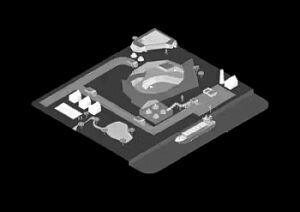 In the hustle and bustle of our daily lives, it’s easy to overlook the silent, unseen threat that lingers in the air around us: dust pollution. While often invisible to the naked eye, dust particles can pose significant health risks and environmental challenges. Understanding the sources, composition, and impact of dust pollution is crucial for safeguarding public health and mitigating its adverse effects.
In the hustle and bustle of our daily lives, it’s easy to overlook the silent, unseen threat that lingers in the air around us: dust pollution. While often invisible to the naked eye, dust particles can pose significant health risks and environmental challenges. Understanding the sources, composition, and impact of dust pollution is crucial for safeguarding public health and mitigating its adverse effects.
In this comprehensive exploration, we delve into the world of dust pollution, from its origins to its far-reaching consequences, shedding light on the critical role of dust monitoring in protecting our well-being.
The Hidden Menace: Sources of Dust Pollution
Dust pollution originates from a myriad of sources, both natural and human-made. Natural sources include wind-blown soil, pollen, volcanic ash, and wildfires, while human activities such as construction, agriculture, transportation, and industrial processes contribute to the release of airborne particles.
These particles vary in size, ranging from coarse sand and soil to finer particulate matter, known as PM10 and PM2.5, which can penetrate deep into the lungs and bloodstream, posing a severe health risk.
Health Implications of Dust Pollution
The health effects of exposure to airborne dust particles are wide-ranging and often underestimated. Short-term exposure can cause respiratory symptoms such as coughing, wheezing, and shortness of breath, particularly in vulnerable populations such as children, the elderly, and individuals with pre-existing respiratory conditions.
Prolonged or repeated exposure to high levels of dust pollution has been linked to more severe health problems, including asthma, chronic obstructive pulmonary disease (COPD), cardiovascular disease, and even premature death. Moreover, recent studies have highlighted potential links between dust exposure and adverse neurological effects, including cognitive decline and dementia.
Environmental Consequences
Beyond its impact on human health, dust pollution also takes a toll on the environment, ecosystems, and wildlife. Dust deposition can degrade soil quality, inhibit plant growth, and contribute to desertification, exacerbating environmental degradation in arid and semi-arid regions.
Additionally, dust particles can carry pollutants such as heavy metals, pesticides, and toxic chemicals, leading to contamination of water bodies and posing risks to aquatic life. Furthermore, dust storms can alter atmospheric conditions, affect weather patterns, and contribute to climate change by transporting significant quantities of dust across continents and oceans.
The Role of Dust Monitoring in Safeguarding Health
Amidst the invisible threat of dust pollution, the importance of dust monitoring cannot be overstated. By deploying monitoring stations equipped with sensors and instruments capable of detecting and measuring airborne dust particles, scientists, environmental agencies, and public health officials can track dust levels in real time, assess exposure risks, and issue timely warnings to the public.
Dust monitoring data also serves as a valuable tool for policymakers in formulating air quality standards, implementing pollution control measures, and safeguarding public health. Furthermore, advancements in satellite technology and remote sensing techniques have enabled the monitoring of dust events on a regional and global scale, facilitating early detection and response to potential health and environmental hazards.
Community Engagement and Public Awareness
Empowering communities with information and resources is crucial for addressing the challenges posed by dust pollution. Citizen science initiatives, educational outreach programs, and public awareness campaigns play a vital role in raising awareness about the health risks associated with dust exposure, promoting proactive measures to reduce emissions, and fostering community resilience.
By encouraging individuals to take simple steps such as proper dust control measures at home, supporting clean air advocacy efforts, and advocating for sustainable land use practices, we can collectively contribute to mitigating the impact of dust pollution on our health and environment.
Conclusion: Navigating the Dusty Path Ahead
As we navigate the dusty path ahead, awareness and action are key to addressing the invisible threat of dust pollution. By understanding the sources, health implications, and environmental consequences of dust pollution, we can take proactive steps to mitigate its impact and protect our health and well-being. Through continued investment in dust monitoring technologies, research, and public outreach, we can pave the way towards cleaner air, healthier communities, and a sustainable future for generations to come.
Remember, while dust pollution may be invisible to the eye, its effects are anything but. Let’s work together to clear the air and ensure a safer, healthier world for all.
Shift Frequency © 2024 – Dust Monitoring:
Shedding Light on an Invisible Hazard
